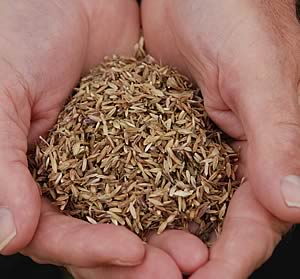Okay, so last week we talked about de-thatching, remember? I hope you took that generous knowledge and put it to good use, and I hope you’ll consider how helpful it (hopefully) was for you and continue reading this with high expectations and low likelihood of disappointment. Because these next steps are just as useful as last week’s. (maybe even more, I am a whole week wiser, you know)
So I will continue on, and after this post we will both have made great strides toward the best lawn in the world (or at least on your block). There are a couple different routes you could take, so let’s see what’s behind door number one…
SCENARIO ONE
“Simply Seeding”
Any questions about what seed to use, check this post out, Seed to Use
With your lawn so freshly de-thatched, it is the perfect time to seed! When the soil is broken up a bit the seeding is entirely more effective, and the de-thatching does a fine job of this. So let’s start seeding. (finally!!)
I know what you’re thinking… isn’t fall the ideal time to seed?
To that I say… yes, but lucky for you there is a small window during the spring that works, too. Just make sure the seed is put down early enough so it has time to germinate before it gets too warm. When the sun comes up and starts beating down on young seedlings, it becomes struggle to survive, so get the seed down early.
The next step after seeding is to think about the fertilizer and lime needs of your lawn. Crabgrass control is an important application to perform, but most weed preventers also happen to prevent grass seed from germinating. So when it is time for you to apply it, try to remember to only apply it to areas that you have not seeded. On the areas you have seeded, you could use instead a starter fertilizer that also controls weeds.
If you buy a crabgrass control product or round 1 product, it is designed to prevent growth. DO NOT apply this product to fresh seed. Instead, find a starter fertilizer with weed control. It is more expensive, but worth it to protect all the seed work you did. Check the package, it should be clear about the goal of the product. Purchase the right one and apply according to the label. It’s ok to use 2 products, one for seed and one for the rest of the lawn. Please feel free to ask us and we can let you know what products to use.
The next step is to complete a lime treatment.
Lime treatments are good to put to use when lawns are weedy, patchy, or yellow. Adding lime helps restore that beautiful green appearance you remember once upon a time. Lime treatments also add calcium and magnesium to soil.
SCENARIO TWO
“Simply Not Seeding”
This scenario plays fairly similarly to scenario one, the only difference being that you skip the seeding and starter fertilizer. The skip means that you can freely use crabgrass control on the entire lawn.
POST-SCENARIO
No matter which scenario you chose, it is so great that you have gone out of your way to complete these steps to improve your lawn. Just remember the order, because it is of upmost importance! (written four times to really set the knowledge in)
Dethatch, Seed, Fertilizer, Lime
Dethatch, Seed, Fertilizer, Lime
Dethatch, Seed, Fertilizer, Lime
Dethatch, Seed, Fertilizer, Lime

